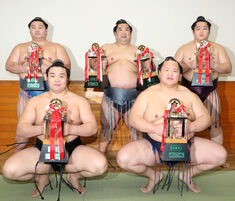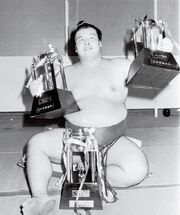
(from left to right) Shodai poses with his kanto-sho (fighting spirit) prize, Kiribayama poses with his kanto-sho, Tokushoryu, who won the overall tournament poses with his shukun-sho (outstanding performance) prize and kanto-sho, Hokutofuji poses with his gino-sho (technique) prize, Endo poses with his shukun-sho. Taken after the January 2020 tournament.
Sansho (三賞, lit: three prizes) are the three special prizes awarded to top (Makuuchi) division sumo wrestlers for exceptional performance during a sumo honbasho or tournament. The prizes were first awarded in November 1947.
Criteria[]
All wrestlers in the top division below the rank of ozeki are eligible. In order to be considered for a special prize a rikishi must make a kachi-koshi or majority of wins during the tournament. Among eligible rikishi, the prize winners are decided by a panel which includes press writers covering the tournament. There is no requirement that the prizes must be awarded, and it sometimes happens that one or more of the sanshō are not given. It is also common for an award to be awarded to more than one wrestler.
The three prizes are
- Shukun-sho (殊勲賞), Outstanding Performance prize
- Kanto-sho (敢闘賞), Fighting Spirit prize
- Gino-sho (技能賞), Technique prize
Typically the Gino-sho is awarded to a wrestler or wrestlers who display the most skillful kimarite, or techniques; the Shukun-shō is awarded to a wrestler who defeats the yokozuna or the eventual tournament winner, or who otherwise displays outstanding performance relative to his rank; and the Kanto-sho to a wrestler who has most clearly fought tenaciously and to the best of his abilities. The Gino-sho is considered the most prestigious, and is also the prize most often not awarded at all: in 1988, it was withheld for five consecutive tournaments. However each award is worth the same amount of money, two million yen.
It is a de facto standard that a newly promoted makuuchi wrestler who manages a 10-5 or better record in his first tournament will be awarded a sanshō, normally the Fighting Spirit prize. Similarly a wrestler newly promoted to the san'yaku ranks above maegashira who achieves a 10-5 record can expect a prize for his efforts.
There is no minimum or maximum limit to the number of sanshō that may be given. It is not uncommon for more than one wrestler to be awarded the same prize, and similarly there are occasions when one of the three sanshō titles is not awarded at all. For example, it is unlikely that the Shukun-sho will be awarded if the tournament is won 15-0 by a lone yokozuna.
At some tournaments as many as six sanshō were awarded in total (as in January 1992), while at others only one has been presented (most recently in March 2016). The September 2018 tournament marked the first time since the introduction of sanshō in 1947 that none of the three prizes were awarded at all.
Sansho Sweeps[]

Daiju Hisateru, the first sumo wrestler to achieve a sansho sweep posing with his prizes after the July, 1973 tournament.
On a few rare occasions, one wrestler has been awarded all three prizes simultaneously for his performance. This accolade has been given on only five separate occasions to five different wrestlers.
| Tournament | Wrestler | Rank | Record |
|---|---|---|---|
| July 1973 | Daiju Hisateru | Sekiwake | 13-2 |
| Sept 1973 | Onishiki Ittetsu | Maegashira 11 | 11-4 |
| Jan 1992 | Takanohana Koji | Maegashira 2 | 14-1 |
| July 1999 | Dejima Takeharu | Sekiwake | 13-2 |
| Nov 2000 | Kotomitsuki Keiji | Maegashira 9 | 13-2 |
*record in bold indicates wrestler also took championship
In September 2001, Kotomitsuki, in his championship tournament, came very close to being the only wrestler to receive all three prizes twice, but the Fighting Spirit prize went to then maegashira Asashoryu.